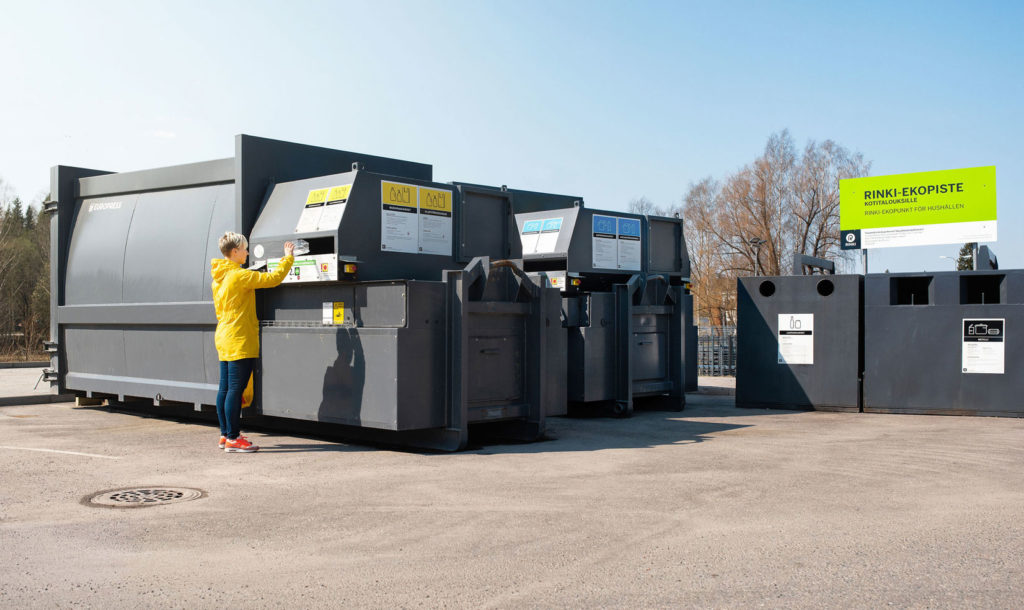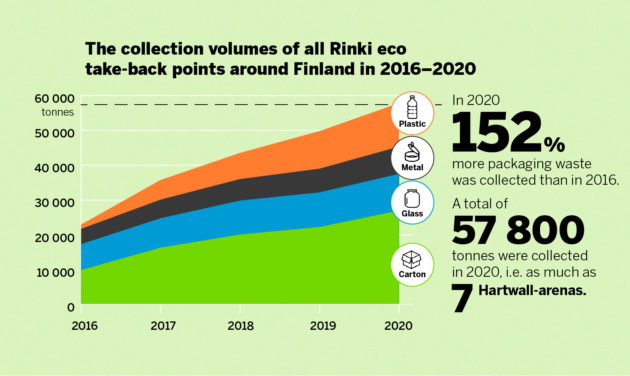The Rinki eco take-back point network is five years old

The responsibility for collecting household packaging waste was transferred from municipalities to packaging producers at the beginning of 2016. That is also when Finnish Packaging Recycling RINKI Ltd took over the responsibility for the collection network and its operations. Rinki provides a collection service for carton, glass, metal and plastic packaging on behalf of producer organisations so they can meet their statutory requirements.
Households can take their carton, glass and plastic packaging waste as well as metal packaging and small metal objects to Rinki eco take-back points.
According to Rinki’s Operative Director Pertti Tammivuori the amount of packaging waste taken to Rinki eco take-back points has increased significantly in the last five years.
– In the first year, about 23,000 tonnes of packaging waste was recycled. That figure has almost trebled, and in 2020 it was close to 60,000 tonnes.
The collection of plastic packaging boosted growth
Tammivuori says that there are several factors behind the growth. First of all, Rinki eco take-back points have been placed near shops to make recycling as easy as possible and help develop it into a routine.
Secondly, people’s awareness of environmental issues and interest in sorting have increased over the years.
Thirdly, households have started to collect and recycle plastic packaging.
– Plastic packaging used not to be sorted in any significant volumes in Finland; it only started in earnest in 2016.
In the first year, 1,200 tonnes of plastic packaging were taken to eco take-back points, compared to almost 13,000 tonnes last year.
– Considerably more plastic packaging is now collected from residential and commercial buildings. As a result, the volume of plastic packaging taken to Rinki eco take-back points no longer growing as quickly as before, says Tammivuori.
Considerably more plastic packaging is now collected from residential and commercial buildings. As a result, the volume of plastic packaging taken to Rinki eco take-back points no longer growing as quickly as before, says Tammivuori.
One explanation for increasing volumes of packaging waste is the growing popularity of online shopping. People order products from online shops in Finland and abroad, which is reflected in the amount of carton packaging waste in particular.
In 2016, 10,000 tonnes of cardboard packaging was collected, and last year that figure was closer to 30,000 tonnes.
The growth in glass and metal packaging collected has been more moderate. Five years ago, 7,000 tonnes of glass packaging and 4,000 tonnes of metal were taken to eco take-back points. Last year, almost 11,000 tonnes of glass packaging and 8,000 tonnes of metal were recycled.
Spending more time at home during the pandemic has increased collection volumes
The coronavirus pandemic has also played a part in eco take-back points becoming busier. Tammivuori says that the amount of packaging waste generated from online shopping has increased even more during the pandemic.
– People have been eager to fix their houses and gardens, and they have bought furniture and other products that come in large and heavy packaging.
The pandemic has had another effect.
– People have spent a lot of time at home. They have eaten a lot of ready-made meals and take-away food, and they have bought more food in general, all of which generate packaging waste.
The growing volumes of packaging have resulted in collection containers at eco take-back points needing to be emptied more often during the pandemic. There have been times when so much material has been taken to the collection points that there has not been enough room for it. This has occasionally caused some mess, and take-back points have been cleaned more often than usual as a consequence.
Customer feedback and data help in running the operations
– The transfer of responsibility for the collection of consumer packaging from municipalities to producers at the start of 2016 was a huge change and, looking back, I think we managed the situation quite well, says Rinki’s CEO Juha-Heikki Tanskanen.
The volumes of materials collected have increased, and the cost-efficiency of the Rinki eco take-back point network has improved year on year. Based on customer surveys, people are also quite satisfied with the level of service.
The number of Rinki eco take-back points was increased to meet the level specified in the waste decree within a very tight timeframe in summer 2016. There are now more than 1,850 Rinki eco take-back points across Finland, and they all accept carton and glass packaging as well as small metal objects. More than 670 Rinki eco take-back points also accept plastic packaging, which is well above the 500 collection points provided for in the decree.
More than 670 Rinki eco take-back points also accept plastic packaging.
Tammivuori says that over the past five years, Rinki has learnt to monitor customer feedback and key figures on its operations and to act on them. Containers are weighed when they are emptied, and this data together with customer feedback allows Rinki to better determine the correct emptying frequency and a suitable cleaning schedule for each point.
Rinki also utilises logistics data in a variety of ways. This allows the company to react to changes in packaging waste volumes more quickly and adapt its logistics operations accordingly. Tammivuori says that this is an area that will also need to be improved in the future.
He thinks that the reforms to the Waste Act will increase the volumes of waste collected from individual properties, which would mean fewer eco take-back points but more packaging waste taken to those that remain.
Tammivuori says that eco take-back points need to remain in places that people naturally pass day to day.
– It is important for consumers that eco take-back points are conveniently located. We receive quite a lot of positive feedback on the fact that many collection points are located next to supermarkets. It makes sense that people can return packaging to the same place they bought it.
There is also usually sufficient space at supermarkets to accommodate Rinki eco take-back points, and they are easy to monitor.
Finnish people are eager to recycle
The recycling rate is high in Finland. In the most recent year for which statistics are available, 2019, 71 per cent of all packaging waste was recycled.
– We have a long tradition of recycling. We learnt to sort glass and cardboard packaging and metal in the 1980s and 1990s. The strongest growth took place in the 2000s, when eco take-back points were opened and legislation requiring properties to collect packaging waste came into force, says Tammivuori.
Consumers have, in general, learned to sort packaging waste correctly.
– There are, however, a small number of people who take waste to collection points that doesn’t belong there, from scrap cars to pieces of furniture and electrical devices. This costs us a lot of money and creates a mess, and it is difficult to combat.
Sometimes people put items in the wrong containers through a lack of knowledge. PVC is mistakenly put into containers for plastic packaging, ceramics and porcelain with glass packaging and electrical and electronic waste into containers for metal. People sometimes forget to flatten cartons, which means that containers fill up very quickly. Sorting instructions can be found on the side of the collection containers and at rinkiin.fi/en/for-households/sorting-instructions/.
Sometimes people put items in the wrong containers through a lack of knowledge.
Rinki eco take-back points are particularly busy during two periods every year:
The Christmas season begins shortly before Christmas and continues until mid-January. There’s a lot of waste from food and gift packaging. The peak is reached on the days around Christmas.
The spring-summer season starts in March, when people start working on their gardens and houses. The Ascension Day weekend is especially busy, and it keeps getting busier until July, when packaging waste from products purchased for holidays and houses cause another peak.
– Packaging waste volumes grow the week after shopping sales peak. It reflects what’s happening in the retail sector, says Tammivuori.
Five years of Rinki eco take-back points
- The Rinki eco take-back point network has been operating for five years.
- During that time, the amount of packaging waste collected has almost trebled, from 23,000 tonnes to 60,000 tonnes.
- The growth results from factors such as an increase in plastic packaging collection and online shopping.
- Customer surveys show that consumers are quite satisfied with the level of service provided by the eco take-back point network.
- 71% of packaging waste was recycled in Finland in 2019.
- The amount of waste taken to Rinki eco take-back points peaks over Christmas, on Ascension Day and in July.
The most popular Rinki eco take-back points in 2020, measured by volume of packaging waste collected
- Joensuu, Voimatie 2 (Prisma Joensuu): 309 tonnes
- Rovaniemi, Teollisuustie 2 (Prisma Rovaniemi): 272 tonnes
- Mäntsälä, Mäntymäentie 2 (K-Citymarket Mäntsälä): 226 tonnes
- Raahe, Ollinkalliontie 2 (K-Citymarket Raahe): 225 tonnes
- Kempele, Zeppeliinintie 1: 216 tonnes
- Kangasala, Mäkirinteentie 10 (Prisma Kangasala): 207 tonnes
- Klaukkala, Isoseppälä 14 (S-Market Klaukkala): 206 tonnes
- Kirkkonummi, Munkinmäentie 29 (Prisma Kirkkonummi): 204 tonnes
- Helsinki, Pikkusuonkuja 1: 197 tonnes
- Parainen, Kirkkoesplanadi 32 (K-Supermarket Reimari): 196 tonnes
